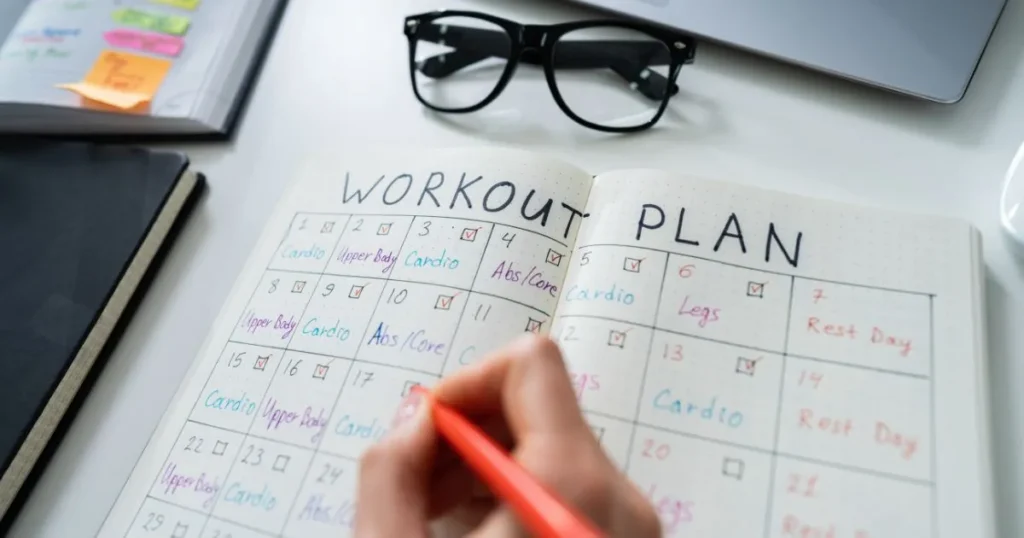Are you having trouble sticking to your workout routine? You’re not alone. Many people find it hard to keep up, whether life gets too busy or progress seems slow.

Staying motivated is key to reaching your fitness goals. In this article, we’ll share useful fitness tips and motivation strategies. These will help you stay focused, full of energy, and committed to your goals, no matter where you begin.
Key Takeaways
- Discover effective ways to boost your workout motivation
- Learn how to create a consistent fitness routine
- Understand the importance of setting realistic fitness goals
- Find out how to track your progress and stay motivated
- Get tips on how to overcome common obstacles in your fitness journey
Why Most People Fail at Fitness (and How You Can Succeed)
Knowing why people fail in fitness can help you make a better workout plan. Many face challenges in keeping up with a fitness routine.
The Common Motivation Killers
One big reason for failure is unrealistic expectations. Having unachievable goals can make you feel let down. Not having clear goals is another major obstacle.
“You don’t have to be great to start, but you have to start to be great.”
Zig Ziglar
The Psychology Behind Sustainable Fitness Habits
Good fitness habits come from psychology. It’s about having a fitness mindset that values progress over perfection. Making small steps can lead to big success over time.
| Motivation Factor | Sustainable Habit |
|---|---|
| Setting Realistic Goals | Achieving small fitness goals |
| Consistency | Regular workout routine |
Setting Your Mindset for Success
To win in fitness, you need to set your mindset right. It’s about knowing how to start and keep going. By aiming for realistic fitness goals, you can find your path to success.

Set Realistic Fitness Goals That Actually Stick
To make lasting changes in your fitness journey, you need to set realistic goals. This means understanding what you want to achieve and creating a roadmap to get there.
The SMART Goal Framework for Fitness Success
The SMART goal framework is a powerful tool for achieving success in your fitness journey. SMART stands for Specific, Measurable, Achievable, Relevant, and Time-bound. By setting SMART goals, you can create clear objectives that are both motivating and attainable.
For example, instead of saying “I want to be healthier,” a SMART goal would be “I will reduce my body fat percentage from 25% to 20% within the next 3 months by exercising for 30 minutes, 3 times a week.”
Breaking Down Big Goals into Daily Actions
Large fitness goals can be overwhelming, but breaking them down into smaller, daily actions makes them more manageable. This approach helps in creating a consistent routine and tracking progress.
- Identify your long-term goal.
- Break it down into smaller, weekly objectives.
- Create a daily schedule to achieve these weekly objectives.

Small Fitness Goals That Lead to Major Results
Achieving small fitness goals can lead to significant results over time. These small victories not only boost motivation but also contribute to the overall progress towards your larger goals.
Examples of Progressive Goal Setting
Progressive goal setting involves gradually increasing the intensity or difficulty of your goals as you achieve them. For instance, if your initial goal is to walk for 30 minutes, 3 times a week, you could progressively increase this to jogging for 30 minutes, 4 times a week, once you’ve consistently achieved your initial goal.
- Start with a manageable goal, such as exercising for 15 minutes, 3 times a week.
- Once you’ve achieved this goal consistently, increase the duration or frequency.
- Continue this pattern of progressive overload to keep challenging yourself.
By following the SMART goal framework and breaking down big goals into smaller, achievable tasks, you can set realistic fitness goals that actually stick. This approach not only enhances your motivation but also ensures long-term success in your fitness journey.
Design Your Ideal Workout Routine
To stay consistent and motivated, you need a workout routine that fits your lifestyle. A well-crafted routine helps you reach your fitness goals and makes the journey enjoyable.
Finding the Perfect Workout Frequency for Your Life
Finding the right workout frequency can be tough. It depends on your goals, fitness level, and schedule. For most, 3 to 4 times per week is a good start. This balance helps you progress without burning out.
Balancing Cardio, Strength, and Flexibility
A good workout routine mixes cardio, strength training, and flexibility exercises. Cardio boosts heart health, strength training builds muscle, and flexibility exercises improve movement. Spread your workouts across these areas.
- Cardio: 1-2 times per week (e.g., running, cycling)
- Strength Training: 2 times per week (e.g., weightlifting, bodyweight exercises)
- Flexibility: 1-2 times per week (e.g., yoga, stretching)
Fitness Routine for Beginners: Where to Start
Beginners should start with short, manageable sessions. Start with 20-30 minute workouts, 2-3 times a week. As you get more comfortable, increase the time and frequency.
Sample Weekly Schedules That Work
Here’s a sample weekly schedule for beginners:
| Day | Workout Type | Duration |
|---|---|---|
| Monday | Cardio (Brisk Walking) | 30 minutes |
| Wednesday | Strength Training (Bodyweight Exercises) | 30 minutes |
| Friday | Flexibility (Yoga) | 30 minutes |

By following these guidelines and tailoring your workout routine to your needs, you’ll be on your way to achieving your fitness goals.
Track Your Fitness Progress Like a Pro
Tracking your fitness progress is more than just looking at numbers. It’s about understanding your journey to a healthier you. By keeping an eye on your progress, you can make smart choices about your workouts. You can also adjust your plan as needed and stay motivated to hit your goals.
Essential Metrics to Monitor Based on Your Goals
The metrics you track should match your fitness goals. For weight loss, watch your weight, body fat, and measurements. For strength training, focus on the weight you lift, how many times you repeat it, and how often you work out.
- Weight and Body Composition: Regularly track changes in weight and body fat percentage.
- Workout Performance: Monitor improvements in strength, endurance, or flexibility.
- Cardiovascular Health: Track heart rate, blood pressure, and other health indicators.
Apps and Tools That Make Tracking Effortless
Today, many apps and tools make tracking your fitness easy. Some popular ones include:
- MyFitnessPal: A calorie tracking app that helps monitor dietary intake.
- Strava: A fitness app that tracks running, cycling, and other activities, providing insights into performance and progress.
- Fitbit: A wearable device that monitors daily activity, sleep, and other health metrics.
Using Data to Stay Motivated When Progress Slows
It’s normal to hit a plateau or slow down. But by looking at your data, you can find patterns and make changes. For example, if you’ve been doing the same workout for months, it’s time to try something new.
“You can’t manage what you don’t measure.” – Peter Drucker
By using the data you’ve collected, you can make smart choices to keep moving forward. This helps you overcome challenges and reach your fitness goals.
Discover Your Powerful “Why” for Unstoppable Motivation

Starting your fitness journey is about finding your true motivation. When you know your “why,” you’ll stick to your goals, even when it’s tough.
Identifying Deep Motivational Drivers
Your “why” is why you started working out. It might be to get healthier, feel more confident, or have more energy. Think about what’s most important to you. Ask yourself, “What values do I hold dear, and how does fitness fit into them?”
Visualize Success in Fitness: Creating Mental Images
Seeing yourself succeed is a great way to stay motivated. Close your eyes and picture yourself reaching your fitness goals. What does success look like to you? How do you feel? Imagining your success can strengthen your “why” and push you to keep going.
How to Reconnect with Your Purpose During Motivation Slumps
Motivation slumps happen, but finding your “why” again can help. Use motivational fitness quotes or look back at your goals to spark your passion. Remember why you started, and let that reason motivate you.
| Motivational Driver | Example | Benefit |
|---|---|---|
| Health Improvement | Reducing blood pressure | Lower risk of chronic diseases |
| Confidence Boost | Feeling more energetic | Increased self-esteem |
| Physical Appearance | Achieving a fitness milestone | Enhanced body image |
Understanding and reconnecting with your “why” helps you overcome challenges and reach your fitness goals.
Build a Support System That Keeps You Accountable
Building a support system is key to keeping your fitness motivation up. Having people who get your fitness journey can give you the push you need. They help you stay focused on your goals.
Finding the Perfect Gym Buddy: What to Look For
Finding a gym buddy can change your fitness game. Look for someone with similar fitness goals and who works out regularly. A good gym buddy should be supportive, motivating, and dependable. Here are some important traits to look for:
- Shared fitness goals
- Consistent workout schedule
- Positive and supportive attitude
- Accountability and reliability
Online and In-Person Fitness Communities Worth Joining
Joining fitness communities online and in-person can boost your support and motivation. Online forums and social media groups connect you with others who share your fitness interests. In-person communities, like local gyms or studios, let you meet people and join group classes or events.
How to Ask for Support When Your Motivation Wavers
When your motivation drops, it’s time to ask for help. Talk to your gym buddy, post on social media fitness groups, or go to a local fitness event. Share your struggles and ask for advice or encouragement.
Creating Accountability Systems That Work
Creating an accountability system helps you stick to your fitness goals. It could be as simple as regular check-ins with your gym buddy or reminders on your phone. You can also use fitness apps to track your progress and share it with your support system.
By building a support system and setting up accountability, you’ll likely stay consistent and reach your fitness goals. Surround yourself with people who support and motivate you. And don’t hesitate to ask for help when you need it.
Master the Science of Fitness Habit Formation
Fitness habit formation is more than just willpower. To build lasting workout habits, you need to understand the psychology behind it. You also need to create an environment that supports your goals.
The 21-Day Myth: How Habits Really Form
The idea that habits form in 21 days is a myth. Research shows it takes different times for habits to form. It can take 18 to 254 days, with an average of 66 days.
Creating Powerful Workout Triggers in Your Environment
Your environment is key in building workout habits. Create strong triggers to help you stick to your routine. For example, wear your workout clothes the night before or find a workout buddy.
Morning Workout Motivation: Starting Your Day Strong
Working out in the morning boosts your morning workout motivation. It sets a positive tone for the day and helps avoid procrastination. Start with small goals, like a 10-minute workout.
Overcoming the “I Don’t Feel Like It” Syndrome
One big challenge is overcoming procrastination. When you don’t feel like working out, remember your growth mindset and why you started. Focus on improving with each workout. Don’t be too hard on yourself if you miss a day or two. Stay motivated by focusing on progress, not perfection.
Reward Yourself for Progress (The Right Way)
Rewarding yourself for progress is a great way to stay motivated. Celebrating your achievements, big or small, helps you keep going. It makes you want to do more.
Effective Non-Food Rewards That Reinforce Consistency
Choosing non-food rewards is key. They should match your fitness goals. Here are some ideas:
- A new workout outfit or accessory
- A massage or spa day
- A fitness tracker or smartwatch
- A fun fitness class or workshop
- A post-workout recovery tool, like a foam roller
These rewards motivate you and support your fitness journey.
Creating a Reward Schedule That Maintains Motivation
Make a reward schedule to tie rewards to milestones. For instance:
| Milestone | Reward |
|---|---|
| Completing a challenging workout routine | A relaxing bath or a new workout playlist |
| Reaching a new personal best | A fitness gadget or a post-workout treat |
| Achieving a long-term goal | A significant non-food reward, like a weekend getaway |
This plan keeps you motivated and gives you something to look forward to.
Celebrating Small Wins for Long-Term Success
Celebrating small victories is key for long-term success. As “Success is the sum of small efforts, repeated day in and day out.” It keeps you motivated and engaged.
With a good reward system, you can stay motivated and reach your fitness goals.
Overcome Fitness Plateaus and Bounce Back from Setbacks
Fitness plateaus and setbacks are common but don’t have to stop you. When you’re on your fitness journey, you’ll face obstacles. Knowing how to handle these challenges is key to success.
Recognizing When You’re in a Plateau vs. Needing Rest
It’s important to tell the difference between a plateau and needing rest. A plateau happens when you’re not making progress, even with hard work. On the other hand, needing rest is your body’s way of saying it’s tired. Listen to your body; if you’re tired, it might be time to rest instead of pushing yourself.
Strategies to Break Through Physical and Mental Stagnation
To get past a plateau, try something new in your workouts. You could increase the intensity, try new exercises, or mix in yoga or Pilates for flexibility and strength. For mental challenges, set new goals or find a workout buddy for motivation.
How to Stay Consistent with Workouts After Injuries or Breaks
Recovering from injuries takes time and a slow return to exercise. Start with easy workouts and slowly add more intensity as you can. Always listen to your body and don’t rush back to your routine to avoid more injuries.
Avoiding Fitness Burnout Through Strategic Recovery
Recovery is crucial to avoid burnout. Make sure to balance workout days with rest days, get enough sleep, and eat well. By focusing on recovery, you can keep up with your workouts without getting too tired.
| Recovery Strategy | Description | Benefits |
|---|---|---|
| Rest Days | Incorporating days off from working out | Allows muscle recovery, reduces risk of injury |
| Proper Nutrition | Eating a balanced diet rich in proteins, carbs, and healthy fats | Supports muscle repair, provides energy for workouts |
| Adequate Sleep | Ensuring 7-9 hours of sleep per night | Aids in recovery, improves mental clarity and focus |
Fitness Tips and Motivation for Lifelong Consistency
To keep up with a fitness routine, finding joy in it is key. A mindset that supports long-term progress is also crucial. There are many ways to stay consistent and reach your fitness goals.
How to Enjoy Your Workout: Finding Activities You Love
It’s important to enjoy your workouts to stay consistent. Try different activities until you find what you love. Whether it’s running, swimming, or dancing, the right exercise should energize and motivate you.
Fitness enthusiast Jane Doe once said,
“Exercise is a celebration of what your body can do, not a punishment for what you ate.”
Finding a workout you enjoy makes sticking to your fitness plan easier.
Motivational Fitness Quotes and How to Use Them Effectively
Motivational quotes can boost your fitness motivation. Quotes like
“You don’t have to be great to start, but you have to start to be great.”
by Zig Ziglar can inspire you to act. Use these quotes to create a motivational space around you. Place them on your fridge, phone wallpaper, or social media.
Developing a Growth Mindset for Continuous Improvement
Having a growth mindset is essential for improving in fitness. It means embracing challenges and seeing failures as learning opportunities. As you progress, you’ll enjoy the journey more than just the destination.
Adapting Your Fitness Journey Through Different Life Stages
Life changes, and so should your fitness routine. Whether you’re a student, working, or retired, your goals and routines may change. Being flexible ensures you can keep a consistent fitness routine all your life.
By using these strategies, you’ll be more likely to stay consistent and reach your fitness goals.
Conclusion: Your Roadmap to Consistent Fitness Success
Reaching consistent fitness success is possible with the right steps. You’ve learned to set achievable goals and create a workout plan. You also know how to track your progress and stay motivated.
Keep moving forward by building lasting habits and celebrating your wins. Enjoy your workouts and believe in your growth. This will help you reach your consistent fitness success goals. Start your fitness roadmap today and get ready to motivate yourself for workout routines that help you reach your goals.
Stay dedicated, and you’ll soon see the results of your hard work.
FAQ
How can I stay motivated to work out?
To stay motivated, set realistic fitness goals. Find a workout buddy and track your progress. Reward yourself for reaching milestones.Understanding what drives you and visualizing success is key.
What are the most effective ways to motivate myself to go to the gym?
Effective ways include setting SMART goals and creating a routine that fits your life. Having a gym buddy and using motivational quotes helps.Tracking your progress and rewarding yourself for achievements boosts motivation.
How do I set realistic fitness goals?
Use the SMART goal framework for realistic goals. Make sure your goals are Specific, Measurable, Achievable, Relevant, and Time-bound.Break down big goals into smaller, daily actions.
What is the importance of having a gym buddy?
A gym buddy adds accountability, support, and motivation. They help you stay on track and make workouts more fun.
How can I track my fitness progress effectively?
Track your progress by monitoring key metrics like weight or workout performance. Use apps and tools to simplify tracking.Use the data to stay motivated.
Why is it hard to stay motivated to exercise daily?
It’s hard due to unrealistic expectations and unclear goals. Understanding your “why” and creating a supportive environment helps.
How can I overcome fitness plateaus?
Recognize when you’re stuck versus needing rest. Change your routine and focus on progressive overload or different exercises.Seek support and adjust your mindset to overcome plateaus.
What are some effective non-food rewards for fitness milestones?
Effective rewards include new workout gear or a massage. Celebrate small wins with non-food rewards to stay motivated.
How can I maintain lifelong consistency in fitness?
Enjoy your workouts and use motivational quotes. Cultivate a growth mindset and adapt your fitness journey through life stages.
What are the benefits of a morning workout?
Morning workouts boost energy and mental clarity. They set a positive tone for the day and help create a consistent habit.
How do I bounce back from a workout injury?
Focus on rest and recovery after an injury. Adjust your routine and seek professional advice. Gradually return to workouts to avoid burnout.